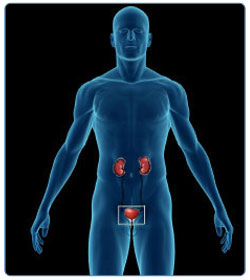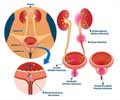- Possible disease remission in patient with invasive bladder cancer with D-fraction regimen - (https://www.ncbi.nlm.nih.gov/pmc/articles/pmc2840560/)
What is Bladder Cancer?
Bladder Cancer is a type of cancer that affects the urinary bladder. The most common type of bladder cancer, known as urothelial cell carcinoma or transitional cell carcinoma, affects the cells lining the bladder. If the cancer is superficial, it indicates a good prognosis and the chances of survival are high. If it is invasive, then the survival rate declines.
It is not clear as to what actually causes the disease but smoking is known to be a major risk factor for bladder cancer. Other risks include exposure to chemicals, family history or being a Caucasian male. There maybe no early symptoms and signs of this condition. Once the diagnosis is established the right treatment can be administered.
Overview of the Urinary Bladder
The main function of the bladder is to collect and store urine produced by the kidneys. Its muscular walls stretch as the urine fills up. When it reaches its capacity, the bladder wall contracts, while the sphincter muscles in the urethra relax and the urine is expelled. This process is known as urination or micturition.
Like all cancers, it is easy to treat bladder cancer when detected early. Therefore, changes in bladder habits or the color of urine must be monitored to help detect the cancer at the earliest.
Bladder cancer can be treated with surgery, chemotherapy, radiation, and biologic therapy. The rate of recurrence for this cancer is high (50-80%); therefore, there is a lot of ongoing research focused on preventing recurrence.
Facts on Bladder Cancer
- Bladder cancer is most common in industrialized countries.
- In the USA it is reported to be the fifth most prevalent type of cancer with 67,000 new cases detected every year and 13,000 people expecting to die from it.
- It affects men three times more than it affects women. It is the fourth most common cancer seen in men and the ninth common cancer seen in women in the USA.
- The cancer is detected late in women than in men.
- Bladder cancer occurs twice as often among whites than other ethnic groups.
- Bladder cancer occurs mostly among older individuals although it has been noted to appear among the younger age groups as well. The average age of diagnosis is in the 60s.
- The cancer has a high rate of recurrence.
What are the Causes and Risk Factors of Bladder Cancer?
It is not clear as to what actually causes bladder cancer but there are several risk factors. Smoking is known to be a major risk factor for bladder cancer. It increases the risk by 2 to 4 fold. Other risks include exposure to chemicals such as aniline dyes, family history or being a Caucasian male. Occupations with an increased risk include textile, dye leather, petroleum, tire / rubber workers, painters, and dry cleaners.
Other changeable risk factors for bladder cancer include the following:
- A diet that includes huge amounts of fried meats and animal fats is thought to be high risk for bladder cancer.
- Chinese remedies - certain Chinese remedies, such as Aristolochia fangchi, synonymous with weight loss have been discovered to contribute to the formation of bladder cancer.
- Age and sex - Older people are at a greater risk for bladder cancer, in particular men are three times more at risk when compared to women.
- Race - Caucasians are a higher risk of developing bladder cancer compared to any other race.
- Family history - A family history of bladder cancer puts a person at a higher risk of getting the disease.
- Chronic bladder inflammation, caused by infections, stones or other urinary tract problems, that inflames or irritates the bladder increases bladder cancer risk.
- Long standing Schistosomiasis (also known as bilharzia, bilharziosis or snail fever) - a common infection in Middle east countries can lead to bladder cancer.
- Birth defects - Certain birth defects result in bladder abnormality and this could eventually lead to the formation of cancer.

What are the Types of Bladder Cancer?
Depending on the type of cells that are affected, bladder cancers are categorized into urothelial carcinoma, squamous cell carcinoma and adenocarcinoma.
Urothelial carcinoma – also known as transitional cell carcinoma, is a very common type of cancer affecting the cells that form the lining of the bladder. When urothelial carcinomas grow into narrow, finger-like projections they are called papillary tumors.
Squamous cell carcinoma – In this type of cancer the thin, flat squamous cells first become inflamed or irritated (due to infection or stones disease or schistosomiasis). This condition may last for months or even years, after which it progresses to a cancerous condition.
Adenocarcinoma – In this type of cancer, the glands of the bladder undergo transformation to become malignant.
Bladder cancer may be superficial or deep and invasive depending on the depth to which the disease has invaded the organ or spread beyond. It is superficial when it confines itself to the innermost lining of the bladder, while the invasive type would have, at least, impacted the bladder’s muscular wall. Urothelial carcinoma can be both superficial and invasive, while squamous cell and adenocarcinoma are the invasive types.
All these cancers can affect any part of the urinary tract, namely, the bladder, kidneys, ureters, or the urethra. If bladder cancer is detected, a proper investigation is necessary to rule out its presence in the neighboring organs.
What are the Symptoms and Signs of Bladder Cancer?
The most common presentation of bladder cancer is blood in the urine, also known as hematuria. Hematuria or blood in the urine is often the first warning of bladder cancer. But in most cases, this is invisible to the naked eye and can be detected only through a laboratory urine analysis. If enough blood is present in the urine, it may take on a light pink or orange color. If one can see blood with the naked eye, it is called gross hematuria and when it is seen under the microscope from a urine sample it is called microscopic hematuria. The risk of bladder cancer is obviously higher is those who have gross hematuria.
Other symptoms of bladder cancer include:
- Pain or burning during urination
- Increased frequency of urination
- Increased urge in urination

How do you Diagnose Bladder Cancer?
The following are the diagnostic tests available for bladder cancer:
Patient history is taken to gather information on the patient’s medical history, occupation and lifestyle habits. This is done in an effort to assess the person’s risk of the cancer.
Physical examination involves inserting a gloved finger into the rectum, vagina, or both, in an effort to detect lumps that might be an indication of a tumor.
Urinalysis: Urine is collected and checked for the presence of blood and also for the level of protein. If the levels are abnormal it has to be followed up with further tests and investigations.
Urine cytology: The cells that comprise the bladder lining are regularly shed and are found in the urine. A microscopic analysis of these cells could reveal abnormal changes in the bladder lining.
Other urine tests can be done to look out for cancer markers, especially to check recurrent cancers.
Cystoscopy: A cystoscope is a narrow tube with a camera and light attached to its end. It is inserted into the bladder via the urethra. The camera transmits pictures of the insides of the bladder to a video monitor. Cystoscopy is akin to endoscopy and is used to detect changes in the bladder.
If a tumor is found during cystoscopy, a biopsy of the bladder wall is taken and examined by pathologists. If the tumor is small, then it is removed during biopsy. Bigger tumors require resection.
Ultrasound, chest X-ray, pyelography, 3D CT scan and a whole body bone scan can help in providing greater details of the abnormalities in the bladder or details related to the spread of the cancer to other body parts (metastasis).
What is the Staging for Bladder Cancer?
Staging refers to the extent to which the cancer has spread inside the person, within the bladder wall and to other parts of the body. This is usually based on the diagnostic tests such as imaging studies and biopsies.
Staging is very important in deciding the course of treatment, recovery and prognosis or outcome of treatment.
High-grade tumors are far more aggressive and life- threatening in comparison to low-grade tumors. The standard International staging is called TNM (Tumor, Node & Metastasis) Staging.
- Stage CIS: Cancer is limited to the innermost lining of the urinary bladder; it is aggressive and high grade.
- Stage Ta: Cancer that is limited to the innermost lining or the superficial mucosal layer of the bladder.
- Stage T1: Cancer that has reached the sub-mucosal tissue (lamina propria) by penetrating the mucosal layer.
- Stage T2: Cancer that has invaded half way through the muscular bladder wall.
- Stage T3: Cancer that has penetrated the muscular bladder wall and reached the surrounding fatty tissues.
- Stage T4: Cancer that has invaded the nearby body organs such as uterus, vagina or the prostate but has not yet reached the lymph nodes.
- Stage T1-4, N1-2, M1-2: Cancer that has spread to the outer abdominal or pelvic wall, to lymph nodes, or to distant organs such as the liver, lungs, or bones.
How do you Treat bladder Cancer?
Treatment of Bladder Cancer is usually through cystoscopic removal of tumor called transurethral resection of bladder tumor (TURBT) or by radical surgery such as removal of the bladder (cystectomy) followed by chemotherapy. Other modalities include immunotherapy or radiotherapy.
Surgery
Surgery is widely used in treating bladder cancer of all types and stages. Different types of surgery are listed below:
- Transurethral resection of Bladder Tumor (TURBT): Here a resectoscope is inserted into the bladder and the tumor is removed using a small wire loop at its end (using controlled heat by using diathermy). Used for treating Ta and T1 cancers or superficial cancer or for taking a biopsy of the tumor.
- Radical cystectomy: Here the whole bladder and the surrounding organs including lymph nodes are removed. Used in the case of invasive and non-responsive type of cancers.
- Segmental or partial cystectomy: Here, part of the bladder is removed and this is usually done for solitary, low-grade tumors.
Urinary tract reconstruction often helps to restore voluntary voiding.
Some patients may receive neoadjuvant chemotherapy before radical cystectomy to kill cancer cells that may have spread to other body parts or to shrink the tumor inside the bladder before the surgery takes place. This treatment has shown to improve long-term survival.
Radiation Therapy
This treatment mainly involves focusing high-energy radiation from a mechanical source onto the affected area and is sometimes advised for inoperable invasive types of cancers.
Radiotherapy may be carried out in place of surgery, and is usually given along with chemotherapy to improve its results. Radiation is usually administered for 5 days a week, for about 5-7 weeks. The actual radiation takes only a few seconds or minutes to administer. This option is usually reserved for patients who are not candidates for major surgery or who do not desire to undergo surgery.
Internal radiotherapy involves inserting a pellet of radioactive material, through the urethra into the urinary bladder. After the required time the pellet is removed.
Side effects of radiation include:
- Normal tissue damage
- Sore dry or itchy skin
- Darkening of the skin
- Destruction of bone marrow cells leading to infections and easy bruising
- Fatigue/ nausea/ diarrhea
- Impotence in men
- Vaginal dryness in women
Chemotherapy
Chemotherapy employs powerful drugs to destroy cancerous cells.
Stages Ta, T1, and CIS bladder cancer are often treated with chemotherapy.
Drugs (usually BCG or mitomycin or doxorubicin) are administered using a catheter into the bladder; this is called intravesical chemotherapy. The drug is retained for about an hour in the bladder and then eliminated from the body while urinating. The patient is asked to turn on the side and on the tummy to ensure the drug comes in contact with all areas within the bladder.
Intravesical chemotherapy, using mitomycin C, has been very effective in treating superficial bladder cancers. It is very often administered as a single dose into the bladder after tumor removal through cystoscopy. This method is not effective for treating invasive type of cancers but does help in preventing recurrence of superficial cancers.
Intravesical chemotherapy is carried out once a week for several weeks at a stretch. The side effects can be symptoms of urinary infection such as frequency of urination or fever or hematuria.
Invasive cancer can be treated with systemic (or intravenous) chemotherapy and various drug regimes are followed depending on the type of regime.
The side effects of systemic chemotherapy include the following:
- Nausea / vomiting
- Lack of hunger
- Fatigue
- Hair loss
- Sores in the mouth / digestive tract
- Susceptibility to infections /easy bleeding
Immunotherapy or biological therapy attempts to boost the body’s natural ability to fight cancer. It is used in treating stages Ta, T1, and carcinoma in situ bladder cancers.
In the case of the widely used intravesical BCG treatment, attenuated vaccine (containing altered Mycobacterium), is introduced into the bladder through the urethra using a thin catheter. The vaccine helps to stimulate the immune system to produce substances that also have the ability to fight cancer.
The ideal time required to retain the vaccine in the bladder is still being argued but ideally patients would need six courses of treatment, usually once a week.
Side effects are temporary. They include:
- Irritation in the bladder
- Slight bleeding in the bladder
- Frequent urination
- Pain / burning during urination
- Nausea
- Slight fever / chills
What is the Prognosis of Bladder Cancer?
Bladder cancer prognosis varies with the stage of the disease and the general health of the affected individual. Age is another factor that influences the prognosis.
- Approximately 90% of people treated for superficial bladder cancer (Ta, T1, CIS) survive for at least five years after treatment.
- Only about 5% of people with metastatic bladder cancer survive for at least two years after diagnosis.
- High-grade recurrent cancer has poor prognosis and low survival rate while low-grade superficial bladder cancer is hardly life-threatening.
Follow up after treatment completion is mandatory to check if the treatment has been effective or not. If cancer cells still remain, further treatment may be required. If not regular tests will be required to check if the cancer has recurred. It may be noted that bladder cancer has a high rate of recurrence. All patients who have been diagnosed with bladder cancer and are treated cystoscopically will require regular cystoscopies at 6 months or one year to look for recurrence of the disease.
How do you Prevent Bladder Cancer?
Some of the effective preventive steps are listed:
- Quit smoking.
- Avoid exposure to unsafe chemicals in the workplace. Use protection if exposure is necessary.
- Drink plenty of fluids to flush out harmful substances.
- Eat plenty of fruits and vegetables, especially mushrooms that are good source of selenium, help lower the risk of bladder cancer.
Chemo prevention: In this method a cancer preventing agent is used to alter the bladder environment in such a way that cancerous cells cannot grow there easily. This is with keeping in mind the fact that bladder cancer is a fast recurring one. Agents, tried and tested, including certain relatively safe drugs and vitamins.
However, no agent has been shown to be consistently successful in preventing bladder cancer.

























